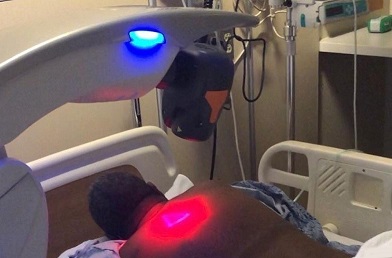COVID-19 News: South African Study Shows That Low-Level Laser Therapy Could Be Used To Treat SARS-CoV-2 Infections!
Nikhil Prasad Fact checked by:Thailand Medical News Team Dec 05, 2023 2 years, 2 weeks, 2 days, 11 hours, 31 minutes ago
COVID-19 News: The ongoing battle against the COVID-19 pandemic has led researchers from the Council of Scientific and Industrial Research, National Laser Centre-South Africa, University of KwaZulu-Natal-South Africa, and University of Cape Town-South Africa to investigate a groundbreaking alternative treatment. This study covered in this
COVID-19 News report, explores the potential of Low-Level Laser Therapy (LLLT) in treating SARS-CoV-2 infections, presenting a new ray of hope in the fight against the virus.
 Low-Level Laser Therapy
The Threat of SARS-CoV-2 Mutations
Low-Level Laser Therapy
The Threat of SARS-CoV-2 Mutations
SARS-CoV-2's ability to undergo crucial mutations poses a significant threat to public health, diminishing vaccine effectiveness and increasing infectivity. The urgency to find alternative and effective methods of controlling the virus has prompted researchers to delve into the potential of Low-Level Laser Therapy (LLLT).
Unprecedented Investigation
This pioneering study aims to investigate, for the first time, the impact of Low-Level Laser Therapy or LLLT on SARS-CoV-2 infected HEK293/ACE2 cells, comparing the effects with uninfected cells. Low-Level Laser Therapy, a therapeutic approach using red and near-infrared light, has demonstrated success in treating various disorders by promoting healing, reducing pain, and restoring function.
SARS-CoV-2: A Formidable Foe
SARS-CoV-2, a single-stranded RNA-enveloped virus, belongs to the coronavirus family and stands out with its severe consequences, causing the 2019 coronavirus disease (COVID-19). Unlike other human coronaviruses, these viruses present death rates of 10%, 37%, and 5% for SARS-CoV, MERS-CoV and SARS-CoV-2, respectively.
Understanding the Virus Genome
The SARS-CoV-2 genome, characterized using next-generation sequencing technology, spans 29,881 base pairs and encodes 9860 amino acids. The virus's surface is adorned with glycosylated S proteins, crucial for binding to the ACE2 receptor on host cells and facilitating viral entry.
Unveiling Low-Level Laser Therapy
LLLT operates by exposing cells or tissues to low levels of red and near-infrared light, triggering cellular responses that accelerate healing and reduce inflammation. Initially described in 1967, LLLT has proven effective in diverse applications, from treating injuries sustained in sports to managing chronic discomfort and even hair loss.
Application of LLLT in Viral Infections
While Low-Level Laser Therapy or LLLT has found success in various biological applications, its application in treating viral infections has been limited. Th
is study seeks to bridge that gap by assessing the impact of LLLT on SARS-CoV-2-infected cells.
Innovative Treatment Approaches
To tackle the challenges posed by SARS-CoV-2, the study proposes innovative treatment approaches, including laser waistcoats, hyperbaric oxygen chambers (HBOT), and nasal laser devices. Laser waistcoats, inspired by successful applications on dogs, could irradiate the lung area for COVID-19 treatment. HBOT chambers with known laser parameters offer direct treatment within a controlled environment, while nasal laser devices provide targeted treatment through the infection's entry point.
Promising Findings and Conclusion
The study's findings reveal that laser irradiation has the potential to reduce SARS-CoV-2 infection in HEK293/ACE2 cells. While a definitive cure for SARS-CoV-2 remains elusive, this study underscores the importance of exploring effective methods to control the virus. Low-Level Laser Therapy or LLLT emerges as a non-aggressive therapy with promising outcomes, offering hope in the global fight against COVID-19.
Further investigations are warranted to delve deeper into the mechanisms behind LLLT's impact on SARS-CoV-2, and the study encourages additional research, including the use of transmission electron microscopy for a more comprehensive analysis. In these challenging times, the study signifies a promising stride toward innovative treatments for the ongoing pandemic.
Addressing Study Limitations
Acknowledging limitations, the study utilized pseudovirus samples instead of real samples. Future research plans involve more complex models, introducing mice infected with SARS-CoV-2 to assess viral load, biopsy samples, and tissue viral concentration. These measures aim to provide a more comprehensive understanding of LLLT's therapeutic potential against SARS-CoV-2.
The study findings were published in the peer reviewed Journal of Biophotonics.
https://onlinelibrary.wiley.com/doi/10.1002/jbio.202300334
For the latest
COVID-19 News, keep on logging to Thailand Medical News.
